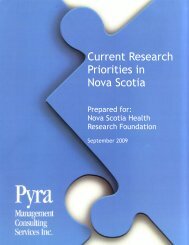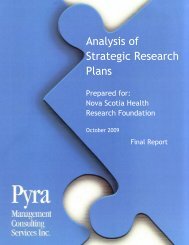Major Health Issues in Nova Scotia: An Environmental Scan
Major Health Issues in Nova Scotia: An Environmental Scan
Major Health Issues in Nova Scotia: An Environmental Scan
You also want an ePaper? Increase the reach of your titles
YUMPU automatically turns print PDFs into web optimized ePapers that Google loves.
# Reference Brief Notes<br />
liv<strong>in</strong>g that the article offers is then applied with<strong>in</strong> the overlapp<strong>in</strong>g area<br />
of hous<strong>in</strong>g and community care to a special case, that of physically<br />
impaired older people, <strong>in</strong> three separate but related <strong>in</strong>stances:<br />
academic, policy and political. Tak<strong>in</strong>g a critique of <strong>in</strong>dependent liv<strong>in</strong>g<br />
beyond theory <strong>in</strong>to policy development may achieve a closer fit<br />
between what older people want their liv<strong>in</strong>g environments to be and<br />
what they are currently presented with. F<strong>in</strong>ally, rather more arguably,<br />
it may also result <strong>in</strong> a more cost-effective use of resources.<br />
6. Popovici,I, French,MT and McKay,JR.<br />
Economic evaluation of cont<strong>in</strong>u<strong>in</strong>g care<br />
<strong>in</strong>terventions <strong>in</strong> the treatment of substance<br />
abuse: Recommendations for future<br />
research. Eval.Rev.; 2008; 32(6):547-68.<br />
7. Roberts,JEA, Browne,G, Gafni,A, et al.<br />
Specialized cont<strong>in</strong>u<strong>in</strong>g care models for<br />
persons with dementia: A systematic review<br />
of the research literature. Canadian Journal on<br />
Ag<strong>in</strong>g; 2000; 19(1):106-26.<br />
8. Rob<strong>in</strong>son,KM and Re<strong>in</strong>hard,SC. Look<strong>in</strong>g<br />
ahead <strong>in</strong> long-term care: The next 50 years.<br />
Nurs.Cl<strong>in</strong>.North Am.; 2009; 44(2):253-62.<br />
The chronic and relaps<strong>in</strong>g nature of substance abuse po<strong>in</strong>ts to the<br />
need for cont<strong>in</strong>u<strong>in</strong>g care after a primary phase of treatment. This<br />
article reviews the economic studies of cont<strong>in</strong>u<strong>in</strong>g care, discusses<br />
research gaps, highlights some of the challenges of conduct<strong>in</strong>g<br />
rigorous economic evaluations of cont<strong>in</strong>u<strong>in</strong>g care, and offers research<br />
guidel<strong>in</strong>es and recommendations for future economic studies <strong>in</strong> this<br />
emerg<strong>in</strong>g field. The adoption of cost-effective cont<strong>in</strong>u<strong>in</strong>g care<br />
services can reduce long-term consequences of addiction, thereby<br />
potentially <strong>in</strong>creas<strong>in</strong>g overall social welfare.<br />
This systematic overview summarizes the published literature<br />
reflect<strong>in</strong>g the effectiveness of services or models of care for persons<br />
with dementia liv<strong>in</strong>g <strong>in</strong> their homes, <strong>in</strong> specialized <strong>in</strong>stitutional care or<br />
assisted liv<strong>in</strong>g centres/congregate homes. First and foremost, more<br />
research is needed that exam<strong>in</strong>es the effectiveness of different<br />
programs for specific persons and their caregivers with different<br />
characteristics and the measurement of family expenditures as well as<br />
costs of programs.<br />
Dur<strong>in</strong>g the next 50 years, demographic ag<strong>in</strong>g-<strong>in</strong>clud<strong>in</strong>g gray<strong>in</strong>g of the<br />
baby boomers, <strong>in</strong>creased longevity, and lower fertility rates-will<br />
change the needs for long-term care <strong>in</strong> the United States. These<br />
trends will have a great impact on the federal budget related to<br />
spend<strong>in</strong>g for Social Security, Medicare, and Medicaid. Future years<br />
will see a more diverse population with <strong>in</strong>creased aggressive treatment<br />
of chronic illness. Consumers of health care and their family<br />
caregivers will take more active steps to manage and coord<strong>in</strong>ate their<br />
own care. Hous<strong>in</strong>g trends that produce more senior-friendly<br />
communities will encourage <strong>in</strong>dependent liv<strong>in</strong>g rather than seniors'<br />
hav<strong>in</strong>g to move <strong>in</strong>to <strong>in</strong>stitutions; <strong>in</strong>creased <strong>in</strong>centives for use of<br />
home- and community community-based care will allow people to<br />
stay longer <strong>in</strong> their own homes <strong>in</strong> the community. Technological<br />
advances, such as the use of robots who serve as companions and<br />
assistants around the house, will also decrease the need for<br />
<strong>in</strong>stitutional liv<strong>in</strong>g.











